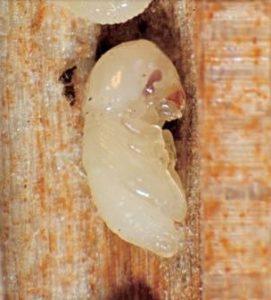The Asian Ambrosia beetle is a member of the “true” weevil family. They are widespread and are primarily known for generating a symbiotic fungus for their consumption. Russian entomologist Victor Ivanovich Motschulsky first described the species in 1866.
Size: 2 to 3 mm
Color: It has a reddish-brown body.
Other Characteristic Features: These beetles are stout, with the males being smaller than females. While the females can fly, the males are flightless.
They are white, legless, and go through several instars before pupating. After hatching, the grubs are cared for by the females until maturing.

Once fully mature, the larvae pupate incol3 the trees instead of a separate pupal tunnel.

Females breed with their siblings and offspring and then lay eggs in bored holes in the preferred host plant.
| Other names | Granulate Ambrosia Beetle |
| Lifespan | 55-60 days |
| Distribution | Native: Asia Invasive: Africa, the Americas, Europe, and Oceania |
| Habitat | Variable; originated from tropical climes |
| Seasons active | Summer |
| Host plants | Buckeye, carob, cherry, crape myrtle, elm, fig, magnolia, peach, plum, pecan, persimmon, Palestine oak, and sweet gum. |
| Diet of adults | The fungus cultivated by the females which is referred to as “ambrosia”. |
The damage these beetles do can be seen in the form of frass tubes sticking out of trees infested by them. Though these beetles majorly infest stressed young trees, they could even at times attack healthy ones bringing down the overall quality of the wood. They may even infest in stacked timber resulting in severe economic damage.
The Asian Ambrosia beetle is a member of the “true” weevil family. They are widespread and are primarily known for generating a symbiotic fungus for their consumption. Russian entomologist Victor Ivanovich Motschulsky first described the species in 1866.
Size: 2 to 3 mm
Color: It has a reddish-brown body.
Other Characteristic Features: These beetles are stout, with the males being smaller than females. While the females can fly, the males are flightless.
They are white, legless, and go through several instars before pupating. After hatching, the grubs are cared for by the females until maturing.

Once fully mature, the larvae pupate incol3 the trees instead of a separate pupal tunnel.

Females breed with their siblings and offspring and then lay eggs in bored holes in the preferred host plant.
| Other names | Granulate Ambrosia Beetle |
| Lifespan | 55-60 days |
| Distribution | Native: Asia Invasive: Africa, the Americas, Europe, and Oceania |
| Habitat | Variable; originated from tropical climes |
| Seasons active | Summer |
| Host plants | Buckeye, carob, cherry, crape myrtle, elm, fig, magnolia, peach, plum, pecan, persimmon, Palestine oak, and sweet gum. |
| Diet of adults | The fungus cultivated by the females which is referred to as “ambrosia”. |
The damage these beetles do can be seen in the form of frass tubes sticking out of trees infested by them. Though these beetles majorly infest stressed young trees, they could even at times attack healthy ones bringing down the overall quality of the wood. They may even infest in stacked timber resulting in severe economic damage.